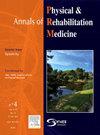社会参与干预对中风幸存者的比较效果:使用社会生态模型的网络荟萃分析
IF 4.6
3区 医学
Q1 REHABILITATION
Annals of Physical and Rehabilitation Medicine
Pub Date : 2025-09-29
DOI:10.1016/j.rehab.2025.102029
引用次数: 0
摘要
社会参与是长期康复的核心指标,但中风后显著下降。不同的单、双或多维干预对改善中风幸存者的参与表现出不同的效果。目的比较目前基于社会生态模型的干预措施在提高脑卒中幸存者社会参与方面的有效性。方法检索自建库至2024年4月的10个电子数据库,并在ProQuest、谷歌Scholar和相关综述的参考文献中进行检索。纳入了以改善18岁及以上中风幸存者社会参与为主要目的的干预措施的随机对照试验。两两荟萃分析和网络荟萃分析。采用累积排序曲线(SUCRA)值下曲面评价干预等级。结果共纳入32篇文献,3211名受试者,其中29篇纳入meta分析。两两荟萃分析表明,与对照组相比,不同的干预措施在干预后有效地改善了社会参与,但在干预后的3、6和12个月则没有效果。网络荟萃分析显示,与对照组相比,个人-物理环境维度干预在改善基线和干预后的社会参与方面最有效(SUCRA 86%, SMD 0.72, 95% CI 0.20-1.25),其次是个人-人际-物理环境维度干预(SUCRA 85%, SMD 0.75, 95% CI 0.23-1.27)。结论:解决个人和物理环境障碍,或额外结合人际关系改善技术,似乎是提高中风幸存者社会参与最有效的方法。研究结果强调需要更严格的多维干预措施来提供有力的证据。本文章由计算机程序翻译,如有差异,请以英文原文为准。
Comparative effects of social participation interventions for stroke survivors: a network meta-analysis using a social ecological model
Background
Social participation is a core indicator of long-term recovery, but it significantly decreases after a stroke. Diverse single-, bi-, or multi-dimensional interventions showed differing effects on improving stroke survivors’ participation.
Objectives
To compare the effectiveness of current interventions based on the social ecological model in improving social participation among stroke survivors.
Methods
Ten electronic databases were searched from their inception to April 2024, and additional searches were conducted in ProQuest, Google Scholar, and the reference lists of relevant reviews. Randomized controlled trials of interventions with the primary aim of improving social participation for stroke survivors aged 18 years and older were included. Pairwise meta-analysis and network meta-analysis were conducted. The intervention hierarchy was evaluated using the surface under the cumulative ranking curve (SUCRA) values.
Results
A total of 32 articles with 3211 participants were included, and 29 articles were eligible for meta-analysis. Pairwise meta-analysis indicated that different interventions were effective in improving social participation compared to control groups at post-intervention, but not at 3, 6, and 12 months after the intervention. The network meta-analysis showed that personal-physical environmental dimensional interventions were the most effective in improving social participation between baseline and post-intervention (SUCRA 86 %, SMD 0.72, 95 % CI 0.20–1.25), followed by personal-interpersonal-physical environmental dimensional interventions (SUCRA 85 %, SMD 0.75, 95 % CI 0.23–1.27) compared to control groups.
Conclusions
Addressing personal and physical environmental barriers, or additionally incorporating interpersonal relationships improvement techniques, appears to be most effective in enhancing social participation among stroke survivors. Findings highlight the need for more rigorous multi-dimensional interventions to provide robust evidence.
求助全文
通过发布文献求助,成功后即可免费获取论文全文。
去求助
来源期刊

Annals of Physical and Rehabilitation Medicine
Medicine-Rehabilitation
CiteScore
7.80
自引率
4.30%
发文量
136
审稿时长
34 days
期刊介绍:
Annals of Physical and Rehabilitation Medicine covers all areas of Rehabilitation and Physical Medicine; such as: methods of evaluation of motor, sensory, cognitive and visceral impairments; acute and chronic musculoskeletal disorders and pain; disabilities in adult and children ; processes of rehabilitation in orthopaedic, rhumatological, neurological, cardiovascular, pulmonary and urological diseases.
 求助内容:
求助内容: 应助结果提醒方式:
应助结果提醒方式:


